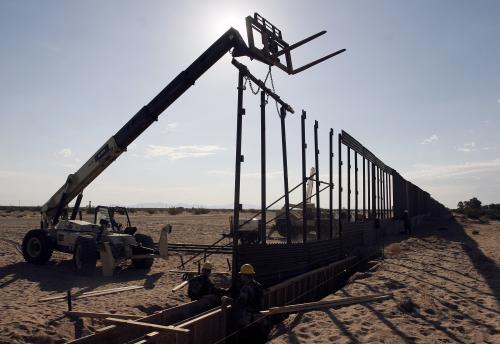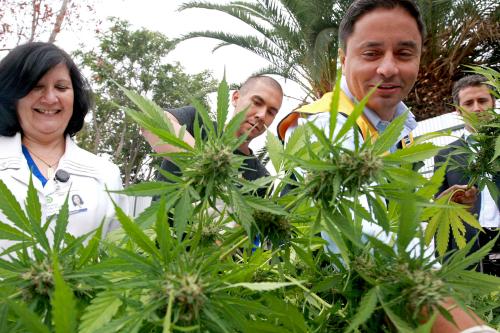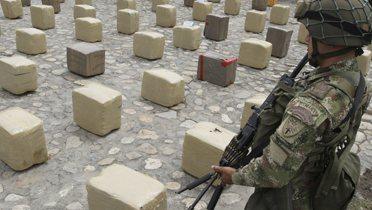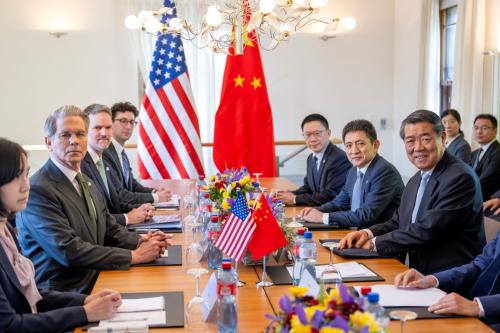Editors’ Note: Illicit trafficking will never be completely eliminated, writes Harold Trinkunas, but it can be shaped to become less violent and increasingly marginal to the economies and societies of Latin America. This post was originally published on The Cipher Brief.
Major and growing illicit trafficking networks link Latin America to Europe, Asia, and North America. Through these networks, illicit drugs and trafficked human beings flow towards the developed world, while dirty money and smuggled guns flow back in return. The criminal enterprises that administer these networks contribute to making Latin America the only region of the world where violent crime, as measured by rates of intentional homicide per 100,000, is rising rather than declining. Countries in the region that sit astride the main nodes in the illicit trafficking networks are the ones that suffer from the worst of the criminal violence.
The shape of the trafficking networks linking Latin America to the developed world can be explained by the geographic distribution of the supply of illicit goods and services. The main illicit drugs trafficked remain relatively constant—cocaine, marijuana, heroin, methamphetamines—but the relative proportion produced by source countries (principally Bolivia, Peru, Colombia, and Mexico) varies across time. Undocumented labor flowing to the United States from the region was historically trafficked from Mexico. However, this flow has largely stopped and even reversed, only to be replaced by a spike of human trafficking from Central America caused in great part by high levels of violence in that region. The main supplier of illicit weapons and money flowing to Latin America continues to be the United States, but other regional arms producers and drug consumers, such as Brazil, play a role as well.
[M]any countries have pursued policies that make the problem worse rather than better.
We have also seen an evolution on the demand side of the equation, as the Brookings Improving Global Drug Policy project shows. The United States remains the largest market globally for illicit drugs, and Latin America is geographically the closest source of illicit drugs and the only source of cocaine. But rising rates of drug use in Europe have led to the establishment of new trafficking networks that use Argentina, Brazil, and Venezuela as transshipment points. And because drug traffickers increasingly pay security and other service providers in transshipment countries in kind (i.e. drugs), local drug use in those countries has risen steadily. Cocaine use per capita in Argentina and Brazil is thought to be approaching levels previously only seen in the United States. This is compounded by the growth of the middle class in Latin America (nearly doubling in size since 2000), which means a growing local demand for all kinds of consumer goods, both licit and illicit, across the region.
Economic integration and democratization across Latin America have produced great increases in trade flows to and from the region, sometimes making transit of illicit goods more difficult to identify. Most experts agree that illegal goods and undocumented migrants are frequently intermingled with legal trade using formal border crossings and ports of entry rather than solely transiting the empty spaces in between. According to United Nations’ statistics, merchandise trade in Latin America more than tripled between 2000 and 2014, greatly increasing the licit “noise” in which the “signal” produced by illicit smuggling can be masked.
Illicit networks are also shaped by the risks and rewards that organized crime faces across different national jurisdictions. Countries with weak institutions, where police lack the dissuasive capacity to shape and deter criminal violence, are the most vulnerable to corruption and the threat of violence posed by transnational organized crime. This makes them the most attractive nodes for production and transshipment of illicit goods. The developed world, principally the United States, has supported (and often demanded) aggressive counter-trafficking and institution building policies in Latin American countries. The track record of such efforts is quite mixed; even when they work in some countries, the result has been to merely shift production and transshipment among the many weakly-institutionalized states in the region (the so-called “balloon effect”). When the risk of producing and shipping drugs from Bolivia and Peru grew during the 1990s, growers shifted north towards Colombia, and then shifted south again following the success of Plan Colombia during the 2000s.
Economic integration and democratization across Latin America have produced great increases in trade flows to and from the region, sometimes making transit of illicit goods more difficult to identify.
While persistent global supply and demand for illicit goods and services makes combating trafficking networks extremely difficult, it is also true that many countries have pursued policies that make the problem worse rather than better. Mass imprisonment of non-violent users and low-level dealers has failed to reduce crime rates in many countries, and often just provides fresh recruits for the trafficking gangs operating both inside and outside the region’s crowded and violent prisons. In addition, imprisoning those who engage in trafficking simply creates a demand signal for another trafficker to step in to supply the market, both in the developed world and in Latin America. Misguided and overly militarized counter-drug efforts have succeeded in disrupting criminal markets in the short term, but the result has been sharp increases in violence in Mexico and Central America in the long term. For example, in the past decade, Mexico has arrested, at one time or another, the heads of every large drug cartel operating on its territory, but the result has been to fragment the seven or eight large cartels into over 100 “cartelitos,” which compete aggressively for control of “plazas” (markets and territory). The rising tide of violence undermines the legitimacy of counter-trafficking efforts and of the states themselves.
Illicit trafficking will never be completely eliminated, but it can be shaped to become less violent and increasingly marginal to the economies and societies of Latin America. There are countries that have succeeded in this endeavor, both relatively wealthy ones, such as Uruguay and Chile, and some of the poorest, such as Nicaragua. Colombia, which was once synonymous with drug-related violence, has recently made great strides towards reducing violence as well. But achieving success on a regional scale requires a number of changes to public policy, both at the global and national levels. It requires addressing the demand side of the equation by fully funding public health measures to contain and reduce the harm posed by drug use, both in the developed world and in Latin America. It requires shifting towards collaborative border security strategies, such as pre-clearance of goods and people from trusted sources and joint binational inspection facilities, to more efficiently inspect and separate the rising (and positive) tide of trade from the intermingled illicit flows of drugs flowing north and guns flowing south. It means that countries that are important destinations for human trafficking should engage in immigration reform and establish well-run temporary worker programs that would channel otherwise law abiding migrants toward legal ways to access economic opportunities. And it means a shift in law enforcement to focus on building the capacity to shape criminal behavior and deter the violence that so threatens public security and undermines citizens’ confidence in the legitimacy of the state.
The Brookings Institution is committed to quality, independence, and impact.
We are supported by a diverse array of funders. In line with our values and policies, each Brookings publication represents the sole views of its author(s).







Commentary
The network effect: Trafficking in illicit drugs, money, and people in Latin America
December 3, 2015